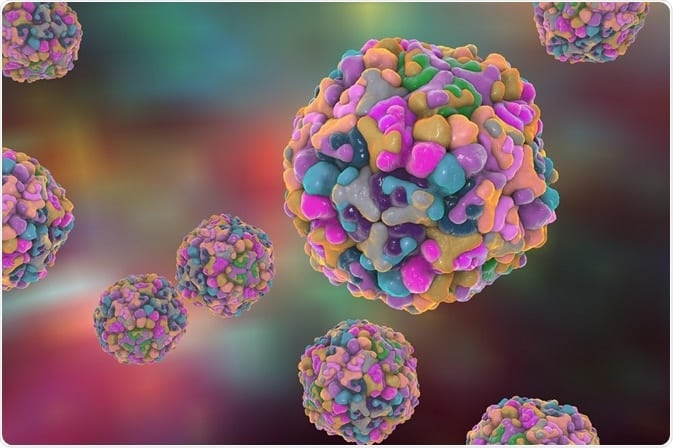Epidemics of enterovirus 71 have been observed recently in parts of the Asia-Pacific region as a major cause of global neurological disease following eradication of poliovirus, EV71 has become a global public concern since then.
Enterovirus 71 causes HFMD and typically affects children, normally it is quickly fought off by the immune system, occasionally EV71 can affect the central nervous system resulting in neurological issues which include brainstem encephalitis, acute flaccid paralysis, and aseptic meningitis; of which brainstem encephalitis is most critical and can result in neurogenic pulmonary oedema that can cause death.
Symptoms of enterovirus 71 infection include random myoclonus muscle contractions, ataxia, brainstem lesions, and cerebrospinal fluid pleocytosis, which occur alongside skin rash. Diagnosis is confirmed once EV71 virus is observed in a throat swab, sample of spinal fluid, or stool samples.
Exact pathogenesis of enterovirus 71 infection in humans is unclear. Studies have indicated the virus is capable of targeting and injuring the central nervous system. Rhesus monkeys studies in 2001 showed that if the virus was contracted via the brain final symptoms resulted in pulmonary oedema, some neuron impairment, and haemorrhage; and if EV71 contracted via respiratory or intravenous inoculations results were a direct infection of the central nervous system as well as inflammation of lung tissue. Based on these findings it is thought that the virus initially replicates in specific organs or tissues, with it being uncontrollably released into the bloodstream during the process causing damage to the targeted organs.
Enterovirus 71 currently does not have an antiviral therapy which is effective against it. During the 2000’s programs developed in Taiwan recommend use of IV immunoglobulin and milrinone for treatment of EV71 brainstem encephalitis, helping to provide essential neutralising antibodies to prepare the immune system to release cytokine to fight the virus off.
EV71 unfortunately has limited treatment options currently making the mortality rate quite high estimated conservatively to be 30-40% during even the acute stages of infection. EV71 infections typically involve the central nervous system, and often end in cardiopulmonary failure, causing extremely low prognosis.
The China Food and Drug Administration approved the world’s first EV71 vaccine which has been shown to be effective at preventing severe cases of HFMD in 2015. Use of the vaccine worldwide is lacking due to a few issues such as lack of effectiveness against different strains of the virus, and international requirements on production of vaccine quality control, and lack of harmonization of different pathogen detection and monitoring methods.




